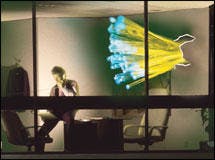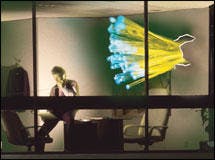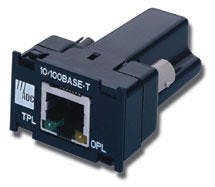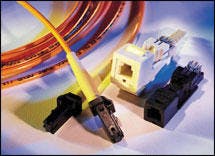The industry's best kept secret may be a myriad of development activities behind fiber-to-the-desk.
By CAROLYN MATHAS
The lack of demand from customers is cited as a major reason fiber hasn't already arrived at the desk en masse (see Lightwave, January 2001, page 26). Over the years, several factors have been cited to explain this fiber-to-the-desk (FTTD) malaise. Just a year ago, the availability of small-form-factor (SFF) connectors without standards to guide the consumer was a primary excuse. This year, the list includes the following: fiber lacks a specific killer application; it's too expensive; it's too fragile, complex, and difficult to work with; and, finally, the realities of the economy.
The truth is that combinations of these factors have existed before, and most still exist in part. Market perception is playing as important a role as reality. Currently, technical and standardization advances and economic pressures are giving rise to support a good case for fiber.
The issue still centers on when. "When" will depend on several things, including whether copper can meet the demands of higher data rates with a standardized solution, and if there will be a painless and cost-effective migration path that allows for incremental upgrades to fiber on the way from 10 Mbits/sec to gigabit speeds and beyond.
Until now, FTTD has been confined to special environments requiring what makes fiber unique: noise and electrical interference immunity, security, extended distances, and high bandwidth at breakneck speeds. Reasons given for not considering fiber include the supposed fragile nature of fiber, a lack of need for that much horsepower, and the complications of transitioning from copper to fiber. Most important, however, potential users look at the "installed first costs" of bringing fiber to the horizontal-and stop there.
Fiber is very strong, maintaining its reliability in extreme temperature and performance situations. But, says Joseph Coffey, senior product engineer at ADC (Minneapolis), "The perception of fragility has some basis in fact. One FTTD end user informed ADC that in 2000 they replaced $21,000 worth of optical patch cords at a workstation due to damage caused by an end user. The damage was a result of stepping on the cord under the desk, rolling over it with a chair, and other human factors."
A high installed first cost is the number one reason given when copper wins over optical fiber. However, many advances over a very short term are promising to inch unshielded twisted-pair (UTP) copper cable and multimode-fiber cable closer to cost parity.
"It's difficult to do an apples-to-apples comparison between the two," says Dave Cook, marketing manager at 3M/Volition (Austin, TX). "In a cost comparison, it often comes down to who supplies the electronics. Although equipment costs are coming down, a customer may have a preferred vendor and find this vendor's fiber electronics prices are substantially higher." Cook explains that the cost hurdle is very real on a one-to-one comparison and that customers need to seek out and take advantage of vendors providing lower-cost electronics and providing architectures that take advantage of fiber.
Bob Lopes, vice chair of the Telecommunications Industry Association's Fiber Optics LAN Section (FOLS) and marketing manager at Micro Linear Corp. (San Jose, CA), agrees: "When you're looking at network interface cards [NICs], for example, you won't find many SX-NICs available, even though there are quite a few great suppliers out there. Micro Linear has several customers in the development stage that are building NIC cards and inexpensive SX converter modules. All of the features and functions that would have accounted for a bill and materials of approximately $70 for a NIC are integrated into a single chip, reducing the cost sevenfold. Based on what our customers are building, I see a 50% reduction in fiber NICs within the year," says Lopes."Cost was a valid objection," admits Bob Pollack, FOLS chair and director of private-network marketing at Corning Cable Systems (Corning, NY). "Where we run into an issue is where someone does a quick pricing model. When we have a chance to work with them and educate them as to the advantages of fiber-telecommunications closets becoming much smaller and the elimination of heating and cooling devices-FTTD barriers become things other than cost," says Pollack.
"That's usually the problem," adds Herb Congdon, Standards Committee chair at FOLS and director of fiber-systems marketing and technical support at Tyco Electronics (Harrisburg, PA). "They design a copper network and try to place a fiber network onto that copper design, making it very expensive," he observes. "When a network is designed taking advantage of fiber giving better distances, higher data rates, it won't cost as much, and over the lifecycle, it may cost less and be a better system."
If the myths or misconceptions are debunked, the realities may be just as difficult to work through for FTTD proponents. "There are two things to consider," says Joe Ramirez, vice president of strategic support at Holocom Networks (San Diego). "There's a total cost of ownership that is a combination of installed first costs and the overall costs incurred down the road. Lifecycle costs are definitely less going with a fiber approach to the desktop. Needed to offset the perception and reality of installed first costs are alternative architectures, network-wide, that don't place such a high dependency on connections all the way out to the desk and all the associated infrastructure and network connectivity components to make sure that happens."
"People aren't spending post-9/11," says Dave Szczepanik, product marketing manager at Sun Conversion Technologies (Quakertown, PA). "But there's a silver lining. In the past several months, even before Sept. 11, there seems to be additional demand for 10-Mbit/sec fiber rather than 100 Mbits/sec. Before this, the mindset was always, why go to 10 when you're going to 100 anyway? Now, they want to do something that they can afford to upgrade their infrastructure-they're going to 10, because it's an improvement over Cat 5 [copper cable]. Once they have 10-Mbit/sec fiber in the system, moving to 100 will be easy."
Citing Micro Linear's strong position in 10-Mbit/sec media converters, Lopes indicates that this area has grown substantially in the past year and states that 10-Mbit/sec infrastructures are still growing. "I see it strong for the next three to four years," Lopes contends. "Yet, this may become another hurdle. Do most customers really need more than 10 Mbits/sec? Do they need 100 outside of applications where higher bandwidth is mandatory?"
For all of the arguments of today's costs being outrageously high, there is rapid development and ongoing deployment of technologies and technical advances under development that promise to deliver fiber-to-the-desk as a viable and cost-effective alternative to copper.
Within the past year, significant advances have been made in product and standards development guaranteed to affect FTTD. Research and development rages on for 100Base-SX ratification; the movement of 10-Gigabit Ethernet into the backbone; the availability of such transition products as media converters, centralized fiber-optic cabling, and "Tiny TR" architectures; and continued advances in SFF connectors.
"At the heart of the cost issue, electronics is the big ticket item," says John Struhar, Membership Committee chair of FOLS and distinguished member, technical staff, fiber-optic application engineering at OFS Brightwave (Murray Hill, NJ). "An optoelectronic transceiver, for example, is one of the highest-cost items in LAN electronics. A considerably lower-cost transceiver may soon be obtainable based on the ANSI/TIA/EIA-786, 100Base-SX Fast Ethernet standard.
"100Base-SX is a lower-cost solution to extend fiber into the horizontal. We recognized that cost is a major hurdle to FTTD. There were really two reasons for the new standard: to reduce cost and to provide an easy transition from 10-Mbit/sec copper to 100 Mbits/sec using a fiber cabling structure capable of Gigabit Ethernet speeds-where no easy transition existed."
The 100Base-SX standard supports the use of the same 850-nm vertical-cavity surface-emitting lasers (VCSELs) used in 10-Mbit/sec Ethernet environments, while 100Base-FX calls for 1310-nm devices. Although some indicate that 100Base-SX, ratified in May 2001 as TIA/EIA-785, has brought costs substantially lower than existing FX technology, Sun Conversion's Szczepanik does not concur. "A couple of years ago, there was a significant cost difference between SX and FX. However, FX active-component prices have come down steadily and the FX/SX gap has diminished. SX doesn't have an edge anymore-it's insignificant," he argues.
Claiming that 1310 nm is common in most of the LAN, Szczepanik calls 850 nm a tough way to go-that it is not compatible with higher-wavelength products and locks users into an SX infrastructure running at 850 nm. With the vast majority of premises networks running at 1310 nm, he indicates that SX is not an attractive alternative, claiming that at Sun Conversion, FX and SX media converters are offered with zero disparity.
"Shortly after the 100Base-SX standard was ratified, a company that manufactures transceivers proposed that the standard be reopened," says Struhar. "They are developing a considerably lower-cost transceiver that currently doesn't support the standard; but with slight modification of the standard, it will easily comply. The objective is to have long-wavelength products come down in price because fiber LAN electronics will be more attractive. At the same time, even lower-cost SX electronics for short-wavelength products will be available soon if this addendum to Standard 785 is adopted."
"Long-wavelength devices on average cost approximately 2.5 times more than short-wavelength devices,'' adds ADC's Coffey. "Since bandwidth of short-wavelength devices supports both 10- and 100-Mbit/sec applications, they are the ideal low-cost solution for FTTD."
"Where people are upgrading their infrastructure as far as structured cabling, they want to put in fiber but not rip out 10-Mbit/sec hubs-they want lower-cost alternatives," says Bill Schultz, director of marketing at Transition Networks (Washington, DC). "That's what we're running into on SX. Although FX certainly predominates, a lot of people aren't aware of the SX standard or the available options. Several resellers, however, are using SX to their advantage in competitive situations."
In addition to SX, several advancements are simultaneously evolving. Gigabit Ethernet is moving FTTD forward. The next Ethernet version-10-Gigabit Ethernet, a fiber standard only-will move into the backbone while Gigabit Ethernet moves closer to the desk. There is growing use of fiber-based Gigabit Ethernet in the LAN backbone and a corresponding uncertainty whether it will run on the latest flavors of twisted wire. Category 5, Category 5E, and Category 6 wiring may need to be upgraded to accommodate the fiber backbone-an electronics-based expense to add to the equation.For companies not quite ready to jump into a complete network upgrade, migration strategies also are evolving. And for installations with mixed media spread throughout the enterprise, media converters offer a way to incrementally move to fiber. They convert data signals on one cabling medium to signals that are transportable on another medium. They can also be used for speed conversion, transitioning between different speeds for different parts of a network.
ADC's new 10/100-Mbit/sec wall outlet converter designed specifically for FTTD applications exemplifies work in this area. "The product is designed to overcome the challenges of cost, complexity, and fragility by placing all of the necessary conversion electronics inside the work-area outlet," explains Coffey. Incorporating many off-the-shelf components and packaging technologies normally used for cell phone and PCMCIA devices, the product complies with 100Base-SX, using short-wavelength optics for the optical interface. The only port accessible to the end user is a standard RJ-45. All fiber connections and signal conversions take place within the wall outlet, eliminating the need for an external fiber patch cord. The elimination of the cord and power module reduces cost, Coffey says.
Where the optics are placed is increasingly up for grabs. Although it's clear that today's telecommunications rooms replete with environmental and temperature controls will become a thing of the past, fiber-friendly architectures housing connections are under serious research and development, with standards in progress.
"Instead of having a traditional centralized architecture where the network's active electronics are located in a closet, new architectures extend the backbone out of the closet and closer to the work group. Copper connectivity is used for the last 30-40 ft," says Holocom's Ramirez. "This eliminates a high number of fiber NIC cards, and media converters aren't required." The concept, the "tiny telecommunications room," affectionately referred to as "Tiny TR," brings greater speeds to the desk and offsets perceived and real first installed costs, Ramirez adds.
Already standardized in the TIA is centralized fiber-optic cabling, another alternative architecture where electronics are located in two areas: the NIC card in the PC/workstation and in the main equipment. No electronics exist in the closet, nor are there additional electronics in the work area. Longer link lengths supported by fiber to centralize electronics are used, reducing the number of active components required, freeing up space used by telecom closets and simplifying maintenance, installation, and troubleshooting. This standard, TIA-568B.1, Centralized Fiber Optic Cabling Architecture, offers potential cost savings. As well, it requires a mindset change for users and designers-as does Tiny TR.
An annex of TIA-568 is TSB-72, Centralized Cabling Guidelines. With this architecture, a NIC connects directly to a router, switch, or hub in a building's central distribution facility. Network managers can take advantage of the long transmission distances supported by multimode fiber's high bandwidth and low attenuation, centralizing LAN electronics in one communications room in a building. As such, networks will require fewer active components, port utilization increases, and wiring closets are eliminated.
"It gets even more interesting when you look at the Category 6 standard and the installation practices that will need to be developed with respect to how the cable is installed and managed," explains Ramirez. "Compared with fiber-optic cable, there's an even more compelling case for optical fiber, given these alternative architectures."
SFF connectors continue to reduce the FTTD price tag and simplify installation. Advances in SFF are important in terms of port density and ease of use. Until recently, applying epoxy, waiting for it to cure, and polishing the epoxy would take as much as 20 minutes. Now, installation of a connector takes as little as one or two minutes.
"Small-form-factor connectors represent a new technology, and we're using new technology to make them lower-cost than standby SC and ST connectors," asserts Paul Herbst, product development manager, fiber-optic connectivity at Panduit (Tinley Park, IL). "There are performance differences in connectors-some are low-cost, some support the highest possible speeds or distances over fiber, some are just a function of vendor preference."
Given all of the advances in delivering fiber to the desktop, fiber may not be the only solution. "A competing solution to FTTD is wireless," says Transition Networks' Schultz. "We see a lot now about increasing the bandwidth for wireless and addressing wireless security issues."
"We're talking 100-Mbit/sec bandwidth for 802.11a," adds TIA's Lopes. "We want to go to fiber to get a higher bandwidth and then people start asking, 'Do we want cable, or do we want wireless?' Achieving over 100 Mbits/sec with wireless causes some hesitation with network builders. This is the other most viable option to fiber."
"The demand for throughput is the driver that will have a major bearing on FTTD near-term," predicts Lloyd Mariner, president of Molex Premise Networks (Hudson, NH). "The newest development being commercialized by Molex and other providers is the introduction of the 10-Gbit/sec multimode-fiber cable to be used in building backbones. 10 Gbits/sec to the desk could be a ways off, but with advances in cable technologies, SFF connectors, Tiny TR, etc., it could be a driver."



